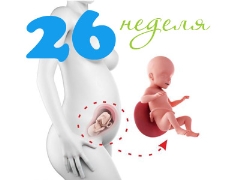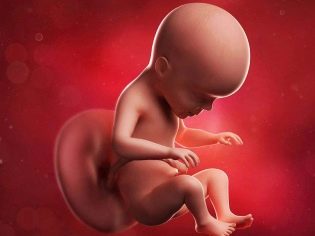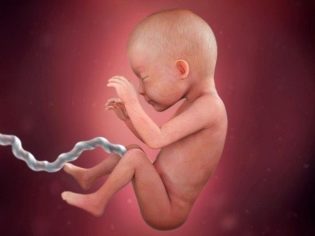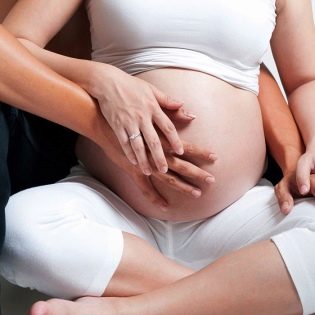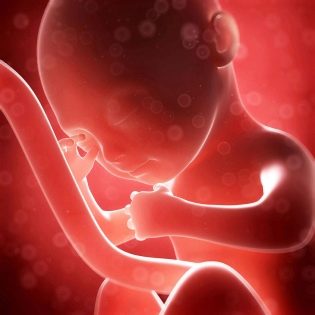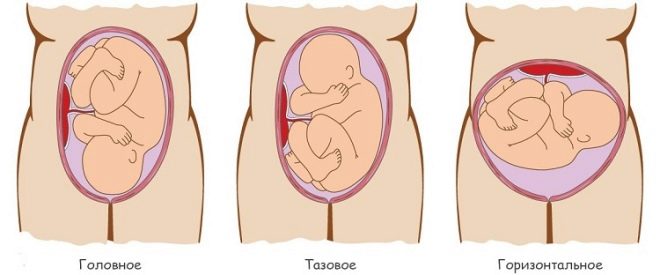Fetal development in the 26th week of pregnancy
Every day, the baby’s intrauterine life is unique. This article will tell about the features of the development of the child at 26 weeks.
Anatomical features of the fetus
To determine how well a baby grows, doctors use a special ultrasound examination method. In the course of such a study, an expert can get the basic dimensions of a little man.
Intensive development of the child contributes to the fact that the normal values of the determined parameters in each week of pregnancy differ.
The table below shows the norms of the main clinical criteria for the parameters of the body of the fetus, which are determined during an ultrasound scan.
Investigated parameter | Norm at 26 weeks gestation |
Growth | 32.5-35 cm |
Weight | 750-850 grams |
Biparietal size (BPR) | 62-73 mm |
Forearm Bone Length | 34-44 mm |
Bone length of shin | 42-49 mm |
Thigh length | 46-53 mm |
Shoulder length | 42-49 mm |
Abdominal circumference | 19.5-24 cm |
Head circumference | 22.5-26.3 cm |
Frontal-nuchal size | 77-94 mm |
In addition to determining the basic parameters of the body, through an ultrasound examination, you can see how the baby looks. The high-precision devices used by specialists at the present time make it possible to obtain an image of a rather high resolution fetus.
The face of the baby by the 26th week is already quite formed. The auricles are small and acquire a more convex configuration. Eyes outside cover their eyelids. Above the child's eye sockets, fluff hairs grow, which will later become the eyebrows. The child even has small eyelashes.
With each subsequent day of pregnancy, the baby becomes more and more cute. His skin becomes smoother and smoother, and the number of wrinkles that cover it earlier is reduced. This is largely due to the fact that under the skin of a baby, the amount of brown fatty tissue begins to actively increase.
The increase in subcutaneous fat contributes to the fact that the baby no longer looks so small and depleted. Dimples and first folds begin to appear on the body of the child. Gradually become plump cheeks.
What does the baby feel?
The intrauterine development of the fetus at this stage of pregnancy is still ongoing, but the basic internal organs and systems have already been formed, and some of them are already beginning to function. However, the internal organs will be able to work in full force only after the birth of the baby, in the meantime their work can be called “training”.
By the 25-26 week of pregnancy, the child has a fairly well functioning nervous system. The brain of a baby weighs about 110-115 grams.
The number of furrows and convolutions, which give the cortex specific striation, continues to increase with each passing day. Such a special structure of the cerebral cortex significantly complicates the behavior of the baby. Every day the child increases the number of reflexes that are necessary for him to further his life.
Without normal development of the nervous system, the functioning of the sense organs is also impossible.By this period, the baby can already feel quite a lot - light, sound, taste and much more. This response to the effects of the environment is largely promoted by the intensive development of the peripheral nervous system.
Ability to hear
The most vivid sensation that a baby experiences at this time is the ability to distinguish sounds. Baby quite easily distinguishes parental voices. It has been scientifically proven that the mother’s voice has a relaxing effect on the fetus.
Interestingly, every day the number of sounds perceived by the child increases. So, he can already perceive the sounds of the environment, making their way through the walls of the abdomen. For example, a baby hears the sound of a vacuum cleaner or water that flows from a water tap.
Sounds of too much intensity may scare the baby. The fetus will show its discontent with increased motor activity. Too loud sounds also contribute to the fact that the child begins to actively kick.
The best sounds for the development of the nervous system - musical works. Experts have found that at this time of intrauterine development, the formation of the first musical preferences is already possible. Listening to classical music can be an excellent option for a future mom and her baby.
No less useful for the development of the child and the natural sounds of nature. Thus, the murmur of the stream or the sound of the sea surf has a calming effect on the fruit. Regular walks in the fresh air can make a child feel positive.
Ability to see
Note that the baby’s real visual analyzer will start working only after its birth. On the term of 26 weeks, the fetus can already close or open the eyes. The structure of the eyeball makes it possible to distinguish light.
Scientists conducted a number of interesting experiments, during which it was proved that when exposed to a stream of bright light on the face of the fetus in the womb, he tries to turn away from him or even change his position.
With excessive insolation, fetal locomotor activity can significantly increase. The kid, as a rule, reacts to too bright light by changing its location or simply by increasing the motor activity.
The ability to taste
Despite the fact that before birth is still far away, the fetus is already able to distinguish taste. Perhaps this is when they swallow amniotic fluid.
During the day, the baby can swallow about 450-600 ml of amniotic fluid. It enters the internal environment of the child's body, where part of the nutrient components dissolved in it are absorbed into the bloodstream, and other substances are simply removed through the kidneys. The main substance that is actively absorbed into the blood is glucose. It is necessary for the child's body for the full development of the brain and nervous system. Some vitamins can also be absorbed.
When the amniotic fluid is swallowed, the fetus feels its taste. In the tongue, the child already has microscopic processes - the nipples. They are peculiar receptors that help a person to feel different flavors. So, quite easily the fruit can distinguish between bitter, salty and sweet tastes.
Swallowing amniotic fluid may cause the baby to hiccup. This reaction is quite normal and serves as a stage in the development of digestion in a baby.
Ability to move
Motor activity of the fetus at this stage, perhaps, is a rather characteristic symptom of 26 weeks. The child is already rather big, his weight has exceeded one pound. This causes the fact that his mother begins to feel the active movements of her child.
Every day the number of movements performed by the fetus increases. This is due to the good development of the musculoskeletal and nervous systems. The bones of the fetus are already quite dense, the muscles are mobile and elastic.All these anatomical features significantly affect the amount of possible active movements performed.
Until that time, the baby was very interested in studying his own body. He played with his umbilical cord, touched his face, bent and unbend fingers on the arms and legs. By week 26, due to the good development of the brain, the fetus has an interest in studying the “water world” in which it is located.
So, his legs, he begins to push off from the walls of the uterus. It is also often the case that the baby begins to “bang” with his hands on the internal organs of his mother, who are quite close to the uterus in which he is located.
It is important to note that by the 26th week the intensity of motor activity in the fetus, as a rule, increases. A woman feels her baby, who is in her womb, much stronger than before.
Some experts note that during the day the baby can be active every 10 minutes. In order to assess the fetus' in utero state, obstetrician-gynecologists advise expectant mothers to count the amount of perturbations they feel.
It is important to note that not all the time the child is active. The baby is already able to sleep in this period of its intrauterine life. The sleep of the fetus is, as a rule, from 17 to 20 hours during the day. At this time, the baby is asleep and does not make active movements.
Motor activity of the fetus is an important clinical criterion for assessing its condition. So, if a baby kicks very often, then this may be a manifestation of the fact that he is experiencing a certain discomfort.
Doctors note that the following common causes can lead to increased motor activity in the fetus.
- Psycho-emotional effects. Stress transferred by the mother, has a very adverse effect on the state of the child's body. Under the influence of stress in the female body produces a number of hormones that cause a spasm of blood vessels. The lack of nutrients and oxygen contributes to the appearance of a response from the fetus.
- Hypoxia - tissue starvation of internal organs. This condition occurs when oxygen supply to the body decreases. Hypoxia can develop for a wide variety of reasons. According to statistics, women living in major cities, suffer from hypoxia much more often.
- Diseases of the mother. Certain pathologies of the heart and blood vessels that occur with the development of heart failure can lead to insufficient nutrient supply necessary for the growth of the fetus.
- Smoking. Proved that regular smoking has a damaging effect on the blood vessels, thereby causing a decrease in the supply of oxygen to the children's body. This situation will also contribute to the strengthening of the motor activity of the fetus, as it causes him pronounced discomfort.
If the expectant mother believes that for some reason her baby has started to show too vigorous activity, then she should definitely discuss it with her obstetrician-gynecologist. Only a doctor who monitors the course of pregnancy can determine whether this condition is an individual feature or is it a manifestation of pathology.
How is it located in the womb?
The location of the fetus in the uterus is a very important clinical sign. On how the baby is located in the womb, will depend on the choice of equipment obstetric aid. So, if the child is in the head presentation, and the woman does not have any severe pathologies, then in this case it is possible to conduct a natural independent delivery, while a pelvic presentation is usually performed a caesarean section. The fact is that The likelihood of developing dangerous traumatic injuries in the latter case is the position of the baby in the uterus is very high.
It is important to note that the way the baby lies in the womb may still change before the birth. This usually happens with very active kids who are restless, who "love" to spin and spin.Before the onset of labor there is still quite a lot of time, which means that doctors will determine the location of the baby in the uterus several times. It often happens that just a few weeks before the birth itself, the baby changes its position.
How the fetus develops in the 26th week of pregnancy, see the following video.
